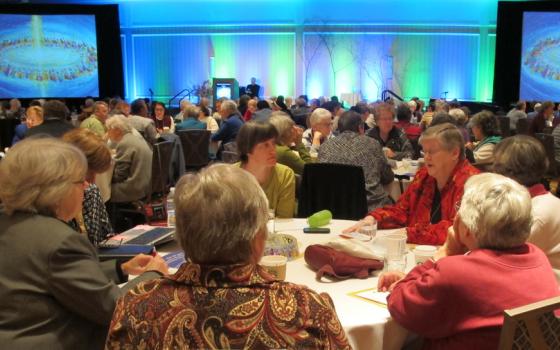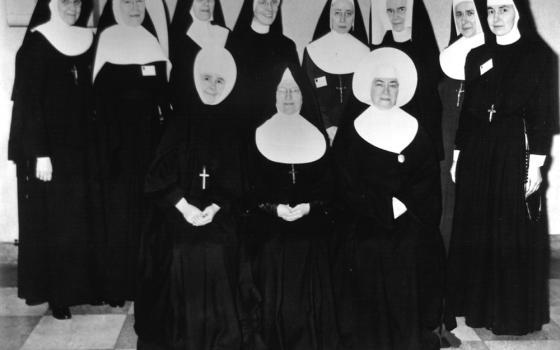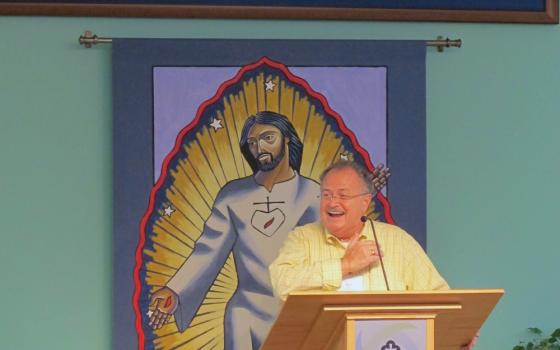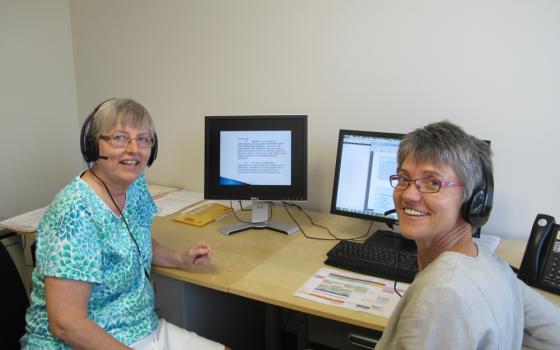Looking out a window in the tiny offices housing the Religious Formation Conference, it’s hard not to notice the U.S. Conference of Catholic Bishops' headquarters next door, towering above everything else in all its stone and glassiness.
“I’m not even sure they know we’re here,” Carol Regan, a Holy Union sister and associate director of the Religious Formation Conference, said with a laugh.
She was joking, but it could be true.
If you ask anyone involved with the Religious Formation Conference, they will probably tell you it’s a vital, albeit often overlooked, group; because of its niche focus on religious life, it doesn’t get the media coverage of the Leadership Conference of Women Religious or even, these days, the Vatican bank. Few Catholics have even heard of it. But since 1954, the conference has been steadily tackling the biggest challenges in formation for religious life. In many ways, the story of the Religious Formation Conference is that of the little engine that could – and did.
This year marks the conference’s 60th anniversary, but before there was a Religious Formation Conference, there was a Sister Formation Conference. Spearheaded in the early 1950s by Mary Emil Penet, an Immaculate Heart of Mary sister, the Sister Formation Conference originally addressed the woefully inadequate way in which sisters teaching in parochial schools were prepared for their ministry.
Today, it’s easy to take for granted the idea that the people teaching our children are actually educated in the topics they teach, but for generations, that wasn’t the case in the nation’s Catholic schools. Sisters, who staffed the schools for nominal pay, were regularly sent into classrooms without state-mandated teaching credentials. As Karen Kennelly, a Sister of St. Joseph, writes in her chronicle of the conference’s first 50 years, a woman would join an order, go through a short initial formation process in which she would learn about religious life and her order’s specific charism, and then she would take over a classroom, all the while piecing together her own education over weekends and summers, often taking 15 or 20 years to earn a bachelor’s degree.
What Penet wanted was a longer initial formation process so new sisters would earn their degrees before entering the classroom, and in 1956, after a series of regional meetings, Penet and a group of highly educated women religious began working out a model curriculum for this new formation program.
“Education for mission was their passion,” said Violet Grennan, a Missionary Franciscan Sister of the Immaculate Conception and the current executive director of the Religious Formation Conference. And, indeed, in an era when only a few hundred thousand women were even attending college, the women behind the model curriculum pushed for a four- to five-year formation program that would give women religious robust liberal arts training and – more controversially – advanced theological education, a field previously reserved solely for male seminarians.
The endeavor was expensive and would deprive parochial schools of a new wave of teachers for several years – facts that many school superintendents and mothers superior openly decried – yet this new concept of formation caught on quickly. By 1964, 80 percent of U.S. sisters had completed at least three years of college before they began teaching. In 1976, the Sister Formation Conference incorporated the formation of men religious into its mission and became the Religious Formation Conference.
But it wasn’t all sunshine and butterflies for the conference. As religious life began to drastically change in the second half of the century, the conference was faced with challenges its founders could not have fathomed and that would fundamentally affect the conference’s mission in the decades to come.
“I don’t think they could have imagined the ways these 60 years have unfolded, I really don’t,” Sr. Carol Regan said. “And yet, here we are 60 years later. I think the conference has exhibited a wonderful ability to deal with unexpected consequences.”
For one, the founders could not have anticipated the drastic drop in the number of men and women entering religious life in the 1970s. Nor could they have anticipated a day where religious would lose what Regan calls their almost “semi-clerical” status within the American church. Since then the conference has recalibrated, even embracing the new place religious occupy in the church and titling their 60th anniversary celebration, “From the Center to the Periphery: Relocating the Prophetic Witness of Religious Life.”
To better serve the nation’s now smaller and older congregations, the conference is stressing a focus on both initial and lifelong formation, taking on topics such as aging well and living in an intercultural environment, which religious may experience both as their missions expand and as their congregations merge and condense.
“We often think of formation as something that happens once and for all,” Regan said. “We’ve gone through ‘it,’ and then we’re formed and life goes on. But in fact, life keeps presenting us with all sorts of possibilities to change and grow. So formation is, in fact, lifelong.”
In that same vein, the conference has also adopted new technologies to share its resources, even offering courses through interactive webinars. In May, the conference finished a series of seven one-hour webinars covering subjects a wide-ranging as communal discernment and legal issues that impact religious life.
“The webinars are reaching and serving a broad and deep range of religious congregations, nationally and internationally,” Sr. Violet Grennan said, noting not only that conference webinars have been viewed on five continents, but also that they are useful for homebound religious who would not ordinarily be able to participate in conference events.
For Steven Dillard, a Jesuit priest and member of the Religious Formation Conference board’s executive committee, it is exactly this type of diverse social networking that is essential for the future of both religious life and the Religious Formation Conference. Lifelong formation, he said, is really about examining religious life in transformation, and with smaller and more international congregations, that means there must be a change in how religious women and men network.
“The heart and soul of religious life is a call from God and a response to that call,” he said, “I don’t see that changing. But the number of those hearing that call and responding in any one charism is low. So sisters and priests and brothers of a variety of congregations have to meet and network with each other for that religious-life support.”
Dillard also pointed out that in small congregations, individuals carry more of the workload, which can lead to burnout if one is not being spiritually nurtured on a regular basis and, instead, waits for a sabbatical.
“I think more and more now, and in the future, we need to make sure people are working on this lifelong formation, not just every 10 years getting six months to go deep,” he said.
It’s difficult to pinpoint in concrete terms what exactly lies ahead for the Religious Formation Conference. As it continues its 60th anniversary celebrations this fall, the conference is still dynamic, responding to the felt needs of religious men and women as they arise. So as religious life continues to evolve, so too will the conference. Grennan, for one, said she “unequivocally” and “without reservation” believes there is a future for religious life and thus a need for initial and lifelong formation.
“Our numbers may be fewer, but the call to religious life and mission remains as relevant today,” she said. “The Religious Formation Conference is alive and well. We remain passionately committed to formation for the sake of life and mission.”
[Dawn Cherie Araujo is a staff writer for Global Sisters Report.]





